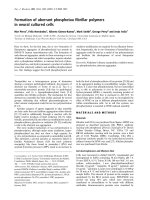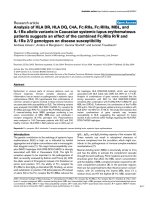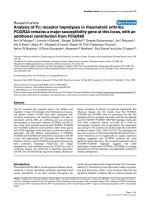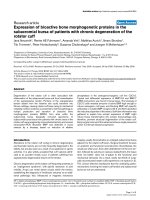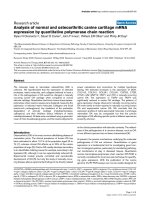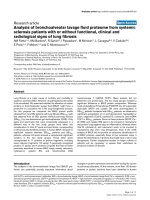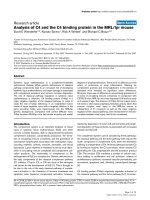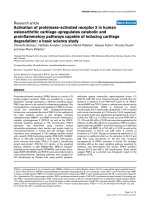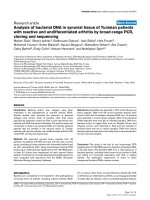Báo cáo y học: "Analysis of the 5''''UTR of HCV genotype 3 grown in vitro in human B cells, T cells, and macrophages" potx
Bạn đang xem bản rút gọn của tài liệu. Xem và tải ngay bản đầy đủ của tài liệu tại đây (3.18 MB, 11 trang )
Revie et al. Virology Journal 2010, 7:155
/>Open Access
RESEARCH
© 2010 Revie et al; licensee BioMed Central Ltd. This is an Open Access article distributed under the terms of the Creative Commons
Attribution License ( which permits unrestricted use, distribution, and reproduction in
any medium, provided the original work is properly cited.
Research
Analysis of the 5'UTR of HCV genotype 3 grown
in
vitro
in human B cells, T cells, and macrophages
Dennis Revie
1
, Michael O Alberti
1,5
, John G Prichard
2
, Ann S Kelley
3
and S Zaki Salahuddin*
4
Abstract
Background: Previously, we have reported the isolation and molecular characterization of human Hepatitis C virus
genotype 1 (HCV-1) from infected patients. We are now reporting an analysis of HCV obtained from patients infected
with HCV genotype 3 (HCV-3) as diagnosed by clinical laboratories.
Results: HCV was cultured in vitro using our system. HCV RNA was isolated from patients' blood and from HCV cultured
in various cell types for up to three months. The 5'UTR of these isolates were used for comparisons. Results revealed a
number of sequence changes as compared to the serum RNA. The HCV RNA produced efficiently by infected
macrophages, B-cells, and T-cells had sequences similar to HCV-1, which suggests that selection of the variants was
performed at the level of macrophages. Virus with sequences similar to HCV-1 replicated better in macrophages than
HCV having a 5'UTR similar to HCV-3.
Conclusions: Although HCV-3 replicates in cell types such as B-cells, T-cells, and macrophages, it may require a
different primary cell type for the same purpose. Therefore, in our opinion, HCV-3 does not replicate efficiently in
macrophages, and patients infected with HCV-3 may contain a population of HCV-1 in their blood.
Background
HCV is associated with a number of diseases, including
hepatocellular carcinoma, B-cell lymphomas, and neu-
ropathy. There is an emerging list of diseases that may
have some association with this virus. Approximately 8%
of HCV-infected individuals in the United States are
infected with genotype 3 [1]. The chances of liver damage
due to HCV infections may not vary by genotype in
untreated individuals [2,3], and infections with HCV-3
are more likely to respond earlier to ribavirin/α-inter-
feron combination therapy than HCV-1 [3-5]. There is
evidence that individuals infected with HCV-3 are likely
to progress rapidly to liver steatosis [6], and fibrosis [7]
compared to infection with HCV-1. Individuals infected
with HCV are also frequently infected with other viruses.
Hematopoietic cells e.g., HCV infected T-cells, are capa-
ble of being co-infected with HIV-1 and HHV-6 [8]. All of
the co-infecting viruses continue to replicate in these
cells.
Although synthetic constructs are commonly used for
HCV related studies, we have a system for studying the
natural virus isolated from infected patients. Reports
using constructs viz., Replicon, pseudo-particles etc. may
have produced interesting data, but these results lack
meaning in the area of human diseases and public health.
Meaningful data must come from viruses isolated from
patients since no Replicon disease yet exists.
The 5'UTR of HCV controls replication through cap-
independent translation [9-11]. For this report, HCV was
isolated from the blood of patients infected with HCV-3
and transmitted into macrophages, B-cells, and T-cells.
The 5'UTR of the progeny viruses was analyzed and com-
pared to the sequences of the HCV RNA found in these
patients' sera. In our previous reports, the 5'UTR of
HCV-1 isolates from patients was analyzed and com-
pared to HCV cultured in vitro and minor differences
were found between the HCV in the isolates and patients'
sera [12,13]. This suggested that the virus in culture was
similar to that found in patients' blood.
Results
The data reported here represents the analysis of the
5'UTR of HCV-3 from three patients (designated samples
314, 384, 388). Primary and secondary isolates analyzed
for the study were cultured in vitro for up to three
* Correspondence:
4
California Institute of Molecular Medicine, Ventura, California, USA
Full list of author information is available at the end of the article
Revie et al. Virology Journal 2010, 7:155
/>Page 2 of 11
months and compared to the HCV RNA from the
patients' sera. The primary isolates are obtained from cul-
tured macrophages. A flow chart of our samples is shown
in Figure 1.
Determination of best primer sets for analyses
For the purposes of this report, we first made degenerate
versions of the primers that were used for HCV-1 [12].
These primers were named 9.1a, 9.2a, and 10.1a (Table 1).
Although these sets of primers were suitable for some
HCV-3 samples (Figure 2B), we were unable to obtain the
appropriate reactivity for the remainder of the samples.
We therefore designed another set of primers to work
with genotypes 1 and 3 (named 8 up and 347 down for
the first PCR; 37 up and 318 down for the second PCR).
Unlike our HCV-1 samples, we were unable to find a sin-
gle set of primers and PCR conditions that always worked
with all of the HCV-3 samples. By testing different com-
binations of primers and temperature conditions, we
were able to generate PCR fragments for all of our sam-
ples (Figure 2 and Table 2).
Comparison of the 5'UTR of HCV from patients' sera and
CIMM-HCV
The first sample of HCV-3 analyzed was from patient
314. Few or no changes in the sequences of the 5'UTR
were observed for cultured HCV-1, but 19 changes in the
sequences for patient 314 RNA were observed (Figure 3).
The sequences for 314 T1 and 314 T2 were the same,
showing that consecutive transfers of HCV into the same
cell type do not affect the sequence. The 314 T1 and T2
sequences were almost identical to genotype 1 H77,
therefore the isolation system for HCV-3 replicated virus
which had a 5'UTR similar to HCV-1. This was unex-
pected, but suggested that there were some HCV-1 in the
blood of patient 314 that preferentially replicated in mac-
rophages.
Due to the data from patient 314, HCV was isolated
and sequenced from patient 384. When comparing 384
serum RNA with the four HCV isolates from that serum,
there were approximately 17 changes for each isolate
(Figure 4), with many of these changes identical to those
found in the isolates from patient 314. Furthermore, since
there were only small differences between primary iso-
lates (cultured in macrophages) and the secondary iso-
lates (cultured in B-cells and T-cells), the macrophages
appear to have selected HCV with a particular sequence
that most closely matched HCV-1. It is possible that
patient 384 also had low levels of HCV-1, which was
amplified in culture. Although the sequences in the
5'UTR that we are reporting for the isolates were almost
identical to H77, we could not amplify the region using
our standard primers for HCV-1 samples (9.1a and 9.2a
then 10.1a and 10.2, Table 1). It may be that the region
upstream or downstream of the reported sequences is
similar to HCV-3.
Next, we isolated and sequenced samples from another
patient infected with HCV genotype 3: patient 388. Com-
paring the serum and the isolates did not reveal large
changes in the sequence. In fact, the only change
observed was an additional C in a string of C's from bases
121 to 126 for sample 388 T1 (Figure 5). A comparison of
sera from patients 314, 384, and 388 revealed that the 388
5'UTR sequence is actually different from the other two
patient serum sequences (Figure 6). Comparisons of the
388 5'UTR sequence and other HCV sequences show that
it is similar to the 5'UTR of HCV-1. Therefore, although a
clinical lab typed the patient samples as being infected
with HCV-3 based on a standard methodology, our
results suggest the presence of HCV-1, as well. This may
have been a clinical testing error. The sequence found in
the macrophages was the same as in the serum.
Other investigators have found that HCV-3 5'UTR
sequences direct translation in an in vitro system about as
efficiently as HCV-1 sequences [14]. However, a recent
report by others compared HCV-1 and HCV-3 5'UTR via
Replicons, and showed that HCV-3 versions replicate
more slowly in their system than HCV-1 [15]. This agrees
with our results that HCV with genotype 1 sequences
preferentially replicate in our system.
Figure 1 Flow chart of HCV isolation at CIMM. Samples in the boxes
were sequenced and analyzed for this report. Cell-free transfers (CFT)
of HCV into freshly prepared cells are indicated by arrows. Cell types are
indicated by colors.
Revie et al. Virology Journal 2010, 7:155
/>Page 3 of 11
Analysis of the sequence variability
Our previous analyses of the sequence variability of the
5'UTR of HCV-1 found a small increase in the variability
of cultured HCV compared to patients' HCV RNA [13].
To see if this also applies to cultured HCV-3, we deter-
mined the variability of the 314 and 384 HCV-3 samples
(Table 3).
Shannon entropy is a measure of the number of differ-
ent genomes in the sample. Genotype 1 and 3 serum and
primary samples have approximately the same Shannon
entropy (Figure 7A). However, HCV-3 cultured in B-cells
and T-cells had lower Shannon entropy than HCV-1, sug-
gesting that particular genomes replicate better in these
cells compared to macrophages. We are in the process of
determining if longer culturing affects the variability.
Pn is a measure of the number of polymorphic sites in
the genome, and is proportional to the number of nucle-
otide positions that vary in the genome. The genotype 3
serum samples have a greater Pn than genotype 1 samples
(Figure 7B). However, the HCV-3 primary, B-cell, and T-
cell HCV samples have lower Pn than HCV-1 samples.
This limited analysis agrees with the Shannon entropy
data in that the variability of the cultured HCV-3 is lower
than HCV-1.
Distribution of variant bases in isolated HCV consensus
sequences
We compared HCV RNA from patient 384 serum and
four laboratory isolates to determine if changes were con-
sistent with the current 2 D model of the 5'UTR RNA
proposed by Honda et al. (2001). The 19 variant bases
were either in regions that are not base paired, or where
the changes would not affect base pairing (Figure 8). So
although there were a number of changes to the sequence
after culturing, these did not appear to cause any differ-
ences that would affect the overall 2 D structure of this
model. All of the differences in the stems had either com-
pensatory changes (e.g. GC to AU at bases 179 and 220)
or could use alternative base pairing (e.g., GC to GU at
bases 145 and 248). We are not sure how these changes
impact the replication of HCV.
Discussion
There are numerous reports about differences between
different strains or types of HCV. We are reporting the
isolation and replication of HCV from patients infected
by type 3 strains of HCV. These new isolates can be cul-
tured in both B and T cells. By contrast to type 1 strains
of HCV, sequence comparisons of the 5'UTR of HCV
found in patients' sera and their corresponding in vitro
Table 1: List of primers for this study.
Primer Strand Starting position Ending position Sequence (5' to 3')
9.1a Positive 24 42 GAC ACT CCA CCA TRG ATC ACT C
9.2a Negative 344 323 CAT GWT GCA CGS TCT ACG AGA C
10.1a Positive 48 71 CTG TGA GGA ACT WCT GTC TTC ACG CRG
10.2 Negative 310 293 CAC TCG CAA GCA CCC TAT CAG
9.1a-flap Positive 24 42 AAT AAA TCA TAA GAC ACT CCA CCA TRG ATC ACT C
9.2a-flap Negative 344 323 AAT AAA TCA TAA CAT GWT GCA CGS TCT ACG AGA C
8 up Positive 11 28 CCC TGA TGG GGG CGA CAC TCC
347 down Negative 345 325 TGC TCA TGG TGC ACG GTC TAC GAG
37 up Positive 41 66 CAC TCC CCT GTG AGG AAC TAC TGT CTT CA
318 down Negative 316 295 CCG GGG CAC TCG CAA GCA CCC TAT C
The starting and ending positions are relative to HCV H77 [26].
Revie et al. Virology Journal 2010, 7:155
/>Page 4 of 11
isolates suggests significant changes in the sequences of
type 3 strains. The replication of other HCV genotypes
such as 2, 4, 5, and 6 in our system is awaiting studies.
As we have published before, macrophages are impor-
tant in selecting HCV-1 for replication [12,16]. Since
these cells are focus of our studies, we would like to name
them as cells that are functionally highly phagocytic and
cytochemically stain intensely for non-specific esterase.
This would include both fixed and free cells such as histi-
ocytes in connective tissue, Kupffer cells of liver, micro-
glial cells of neuronal tissue, dendritic cells of skin, and
alveolar macrophages to name a few. The presence of
HCV in monocytes or macrophages has been shown in
HCV-infected individuals [17-21]. In addition, like HIV,
infected macrophages may act as a reservoir of biologi-
cally active, infectious HCV in vivo. Although, we have
had some success in isolating HCV-3, the system is not
optimal. Other types of macrophages, e.g. Kupffer cells,
are probably better for replication of genotype 3. Results
presented here show that we were able to isolate and cul-
ture HCV from patients infected with HCV-3 to a limited
extent. However, the HCV-3 produced by macrophages,
B-cells, and T-cells were significantly different from
HCV-3 in the patients' sera (Figures 3 and 4).
We were unable to find one set of PCR primers and
conditions that worked for all of our samples. For geno-
type 1, we routinely use the same set of conditions for the
analysis of the 5'UTR. For genotype 3, we found that
some samples would not work for any particular set of
PCR conditions. This is presumably due to a high degree
of variability of HCV-3.
Our studies indicate that the macrophages preferen-
tially select HCV-1, making them the dominant virus
type (Figure 4), and HCV-3 may poorly infect mac-
rophages from cord blood. The reduced sequence com-
plexity of HCV-3 cultured in B-cells and T-cells suggests
Table 2: List of samples and PCR conditions in this study.
Isolate Cell type Date of
transmission
Clones
sequenced
Outer PCR
primers
Outer PCR
Temp.
Inner
primers
Inner
Temp.
314 serum All 1/5/05 25 9.1a-9.2a 55 10.1a-10.2 60
314 T1 B cell 1/13/05 17 9.1a-9.2a 55 10.1a-10.2 60
314 T2 B cell 2/4/05 5 9.1a-9.2a 55 10.1a-10.2 60
384 serum All 1/8/08 24 8 up-347
down
50 37 up-318
down
55
384 primary Macrophage 1/30/08 26 8 up-347
down
55 37 up-318
down
55
384 P3HR1 B cell 1/30/08 25 9.1a-flap-
9.2a-flap
50 10.1a-10.2 60
384 CEM T cell 1/30/08 27 8 up-347
down
50 37 up-318
down
55
384 CB Macrophage 4/7/08 8 8 up-347
down
55 37 up-318
down
55
388 serum All 9/10/08 6 8 up-347
down
50 37 up-318
down
60
388 primary Macrophage 9/12/08 5 8 up-347
down
50 37 up-318
down
60
388 T1 B cell 9/18/08 4 8 up-347
down
50 37 up-318
down
60
Revie et al. Virology Journal 2010, 7:155
/>Page 5 of 11
that macrophages are selecting against this genotype.
Sera from patients 314 and 384 had HCV-3 sequences,
while the HCV in macrophages and other cell types was
only HCV-1.
The 388 T1 sample (B-cells) had 8 C's starting at posi-
tion 120, compared to 7 for the 388 serum and 388 pri-
mary (macrophage) samples. Although we only
sequenced four clones for this sample, every one of them
had an extra C. We have previously observed an addi-
tional C in several HCV-1 samples [13]. In addition, we
have found a large deletion in this area for one sample
[16]. This region is located between stem-loops II and III,
thus apparently allowing greater variability. HCV needs
to be infectious, and the level of replication of these infec-
tious agents will depend upon a number of factors, most
importantly the target cells.
The results presented here suggest that HCV-3 may
need a different cell type for its primary replication in
vitro. Our previous publications document the selection
of HCV-1 in macrophages or similar cells viz., neuronal
Figure 2 Gel electrophoresis of patient 384 RT-PCR products using various sets of primers. For short time cultures and analyses, we have used
cloned cell lines such as P3HR1 and CEM. This was for the purposes of reproducibility and economy. A. Primer sets 9.1a-9.2a (1
st
PCR) and 37up-
318down (2
nd
PCR). Only 384 serum produced a positive band. CB designates Macrophages purified from cord blood. P3HR1-b and CB-b were super-
natants collected at different times than P3HR1 and CB. B. Primer sets 9.1a-9.2a (1
st
PCR) and 10.1a-10.2 (2
nd
PCR). Only P3HR1 produced positive bands.
C. Primer sets 8up-347down (1
st
PCR) and 37up-318down (2
nd
PCR). First PCR at 50°C. Only CEM produced positive bands. D. Primer sets 8up-347down
(1
st
PCR) and 37up-318down (2
nd
PCR). First PCR at 55°C. Primary, P3HR1-b, and Cord blood macrophages produced positive bands.
Revie et al. Virology Journal 2010, 7:155
/>Page 6 of 11
Figure 3 Comparisons of 5'UTR consensus sequences between patient 314 serum and isolates of HCV. H77, GenBank accession number
NC_004102
, is shown for comparison purposes and was not used to determine the consensus.
Figure 4 Comparisons of 5'UTR consensus sequences between patient 384 serum and isolates of HCV. H77 is shown for comparison purposes
and was not used to determine the consensus.
Revie et al. Virology Journal 2010, 7:155
/>Page 7 of 11
Figure 5 Comparisons of 5'UTR consensus sequences between patient 388 serum and isolates of HCV. H77 is shown for comparison purposes
and was not used to determine the consensus.
Figure 6 Comparisons of 5'UTR consensus sequences of sera from patients 314, 384, and 388. NZL1 is a reference HCV-3 at NCBI Entrez genome
(accession number NC_009824), is shown for comparison purposes and was not used to determine the consensus sequence.
Revie et al. Virology Journal 2010, 7:155
/>Page 8 of 11
precursors. Individuals infected with genotype 3 may
have small amounts of other genotypes circulating in
their blood. It is possible that these other genotypes may
also prefer to infect specific cell types for replication in
vitro. Others have shown that different tissues in one par-
ticular individual may harbor different genotypes of HCV
[22-24], suggesting that cell tropism may establish the tis-
sue specificity of HCV in infected individuals. Variability
in diseases of HCV-infected individuals, such as neuropa-
thy and lymphoma, may either be due to variations in the
virus or to increased susceptibility of infected cell types,
or the presence of other viral agents in circulation. This
phenomenon is under further investigation.
Methods
Patient samples
All patient samples were given a code at the source, and a
sequential number in our laboratory to preserve their
anonymity. Patients 314, 384, and 388 were all AIDS
patients doubly infected with HIV and HCV. The HCV
was genotyped as type 3 using an INNO-LiPA assay by a
clinical testing laboratory (Quest Diagnostics).
In vitro culture system
Our culture system, described earlier, takes advantage of
the infectious particles present in the peripheral circula-
tion [12]. Briefly, the isolation of HCV was done in two
stages: (A) HCV derived from patients' blood was used to
infect human macrophages; (B) HCV obtained from the
macrophages was then used to infect freshly transformed
B-cells or T-cells obtained from human fetal cord blood
and cultured in the presence of 100 units/ml of IL-2 (Col-
laborative Biomedical Products, catalog number 40121).
The types of samples that were analyzed included: (i)
HCV found in serum or plasma of patients; (ii) HCV pro-
duced by macrophages (primary isolate); and (iii) HCV
produced by B-cells or T-cells (secondary isolates). Each
sample was given a unique number that indicated the
patient and a suffix designating replication into various
cell types. Transfers into fresh uninfected B-cells were
given a suffix of T1, transfers into cell lines, such as
P3HR1 and CEM, were given a suffix of the cell line
name, and secondary transfers into macrophages pro-
duced from human cord blood (CB). All isolates were
produced in the laboratories at CIMM, and are therefore
called CIMM-HCV. The data in this paper is based on
these isolates.
CEM.NCI and CEM.SS cells were obtained through the
NIH AIDS Research and Reference Reagent Program,
Division of AIDS, NIAID, NIH. P3HR1 cells were
obtained from ATCC. The cell types were cultured using
the methods recommended by ATCC. Single cell clones
were established from these cell lines for the sake of uni-
formity of data and the removal of adventitious material
such as mycoplasma.
RT-PCR
RNA was purified using TriReagent as previously
described [12], and a nested RT-PCR was performed. For
the patient 314 samples, the procedure was as previously
described using Fidelitaq (US Biochemicals) [12]. For the
other patient samples, RT was performed using N
12
ran-
dom primers for 12 12-minute cycles at 48°C using cyclic
RT (Bioneer). The PCR was performed using Bioneer
high fidelity TLA PCR premixes. The primers used for
the experiments are listed in Table 1.
For each TLA PCR reaction, samples were denatured at
94°C for 3 minutes, and then 30 cycles of amplification
were performed with the following temperature profiles:
94°C for 30 seconds, 50 or 55°C for 30 seconds, and 72°C
Table 3: Sequence complexity of genotype 3 HCV samples.
Sample Number Shannon entropy (Sn) Pn (10-3)
314 serum 26 0.50 2.46
314 T1 17 0.15 0.11
384 serum 24 0.26 2.01
384 primary 26 0.53 0.84
384 P3HR1 25 0.26 1.05
384 CEM 27 0.41 1.14
Pn variability and Shannon entropy, normalized for the number of samples, were calculated as described by Cabot et al. [27] and Pawlotsky
et al. [28].
Revie et al. Virology Journal 2010, 7:155
/>Page 9 of 11
for 1 min for the outer primer set and 94°C for 30 sec-
onds, 55 or 60°C for 30 seconds, and 72°C for 1 min for
the inner primer set (Table 2). Normally, 2 ml of RNA was
used for the RT, 2 ml of the cDNA used for the first PCR,
and 2 ml of the first PCR product for the second PCR.
Volumes were adjusted as needed.
Sequencing
Fragments comprising approximately 263 or 276 bp of
the 5'UTR generated by nested PCR were cloned using
Invitrogen's ZeroBlunt cloning kit. Plasmid DNA from a
minimum of 4 clones of each sample were amplified by
Templiphi (Amersham) and then sequenced using a
Figure 7 Sequence complexity of genotype 3 HCV samples. (A) Shannon entropy comparisons of genotypes 1 and 3 HCV cultured in various cell
types. (B) The Pn variability of genotype 1 and 3 HCV cultured in various cell types. The genotype 1 values are from Revie et al. [13]. The ranges are
indicated by vertical bars and the means by thick horizontal lines.
Revie et al. Virology Journal 2010, 7:155
/>Page 10 of 11
Beckman CEQ8000 Genetic Analysis system. In order to
ensure high quality analyses, only clones that had identi-
cal sequences for both strands were analyzed. All meth-
ods followed the manufacturers' protocols.
Bioinformatics
Analysis of the sequences was performed as described
previously [13]. The numbers for the base positions that
are reported here are the bases compared to the positions
of the full length genome of HCV H77 [25,26].
Complexity of the variation was calculated as Shannon
entropy and Pn complexity as described previously [13].
Only samples with at least 17 sequences were analyzed
for variation.
Accession numbers of HCV sequences used for genotyping
The 5' UTR sequences reported in the paper have the
GenBank accession numbers HM641722
to HM641732.
Competing interests
All intellectual rights are reserved by the California Institute of Molecular Medi-
cine (CIMM). There are no competing interests between California Lutheran
University or any other body and CIMM.
Authors' contributions
SZS performed the biological work. JGP and ASK performed the clinical work,
recruitment of patients, and procurement of specimens. MOA designed exper-
iments and performed molecular work. SZS and DR designed and conducted
experiments, analyzed the data, and wrote the manuscript. All of the authors
have read and approved the final manuscript.
Figure 8 Variation in the bases of 384 isolates. The 384 serum sample is used for the figure, with sequence changes found in the isolates indicated.
The table lists each isolate and the base at each position in the sequence. The arrows indicate the limits of the reported sequences. The figure is adapt-
ed from Lyons et al. [29].
Revie et al. Virology Journal 2010, 7:155
/>Page 11 of 11
Acknowledgements
We wish to thank Renu Grewal and Herbinder Grewal for their technical assis-
tance.
Author Details
1
Department of Biology, California Lutheran University, Thousand Oaks,
California, USA,
2
Ventura County Medical Center, Ventura, California, USA,
3
Ventura County Hematology-Oncology Specialists, Oxnard, CA, USA,
4
California Institute of Molecular Medicine, Ventura, California, USA and
5
Division of Human Gene Therapy, Department of Medicine, University of
Alabama at Birmingham, Birmingham, AL, USA
References
1. Rustgi VK: The epidemiology of hepatitis C infection in the United
States. J Gastroenterol 2007, 42:513-521.
2. Mangia A, Cascavilla I, Lezzi G, Spirito F, Maertens G, Parlatore L, Saracco G,
Rizzetto M, Andriulli A: HCV genotypes in patients with liver disease of
different stages and severity. J Hepatol 1997, 26:1173-1178.
3. NIH Consensus Statement on Management of Hepatitis C: 2002. NIH
Consens State Sci Statements 2002, 19:1-46.
4. Tarantino G, Craxi A: Optimizing the treatment of chronic hepatitis due
to hepatitis C virus genotypes 2 and 3: a review. Liver Int 2009, 29(Suppl
1):31-38.
5. Weigand K, Stremmel W, Encke J: Treatment of hepatitis C virus
infection. World J Gastroenterol 2007, 13:1897-1905.
6. Asselah T, Rubbia-Brandt L, Marcellin P, Negro F: Steatosis in chronic
hepatitis C: why does it really matter? Gut 2006, 55:123-130.
7. Bochud PY, Cai T, Overbeck K, Bochud M, Dufour JF, Mullhaupt B,
Borovicka J, Heim M, Moradpour D, Cerny A, et al.: Genotype 3 is
associated with accelerated fibrosis progression in chronic hepatitis C.
J Hepatol 2009, 51(4):655-66.
8. Salahuddin SZ, Snyder KA, Godwin A, Grewal R, Prichard JG, Kelley AS,
Revie D: The simultaneous presence and expression of human hepatitis
C virus (HCV), human herpesvirus-6 (HHV-6), and human
immunodeficiency virus-1 (HIV-1) in a single human T-cell. Virol J 2007,
4:106.
9. Friebe P, Lohmann V, Krieger N, Bartenschlager R: Sequences in the 5'
nontranslated region of hepatitis C virus required for RNA replication.
J Virol 2001, 75:12047-12057.
10. Rijnbrand R, Bredenbeek P, van der Straaten T, Whetter L, Inchauspe G,
Lemon S, Spaan W: Almost the entire 5' non-translated region of
hepatitis C virus is required for cap-independent translation. FEBS Lett
1995, 365:115-119.
11. Wang C, Sarnow P, Siddiqui A: Translation of human hepatitis C virus
RNA in cultured cells is mediated by an internal ribosome-binding
mechanism. J Virol 1993, 67:3338-3344.
12. Revie D, Braich RS, Bayles D, Chelyapov N, Khan R, Geer C, Reisman R,
Kelley AS, Prichard JG, Salahuddin SZ: Transmission of human hepatitis C
virus from patients in secondary cells for long term culture. Virol J 2005,
2:37.
13. Revie D, Alberti MO, Braich RS, Chelyapov N, Bayles D, Prichard JG,
Salahuddin SZ: Analysis of in vitro replicated human hepatitis C virus
(HCV) for the determination of genotypes and quasispecies. Virol J
2006, 3:81.
14. Barria MI, Gonzalez A, Vera-Otarola J, Leon U, Vollrath V, Marsac D,
Monasterio O, Perez-Acle T, Soza A, Lopez-Lastra M: Analysis of natural
variants of the hepatitis C virus internal ribosome entry site reveals
that primary sequence plays a key role in cap-independent translation.
Nucleic Acids Res 2009, 37:957-971.
15. Masante C, Mahias K, Lourenco S, Dumas E, Cahour A, Trimoulet P, Fleury
H, Astier-Gin T, Ventura M: Seven nucleotide changes characteristic of
the hepatitis C virus genotype 3 5' untranslated region: correlation
with reduced in vitro replication. J Gen Virol 2008, 89:212-221.
16. Revie D, Alberti MO, Braich RS, Bayles D, Prichard JG, Salahuddin SZ:
Discovery of significant variants containing large deletions in the
5'UTR of human hepatitis C virus (HCV). Virol J 2006, 3:82.
17. Chang TT, Young KC, Yang YJ, Lei HY, Wu HL: Hepatitis C virus RNA in
peripheral blood mononuclear cells: comparing acute and chronic
hepatitis C virus infection. Hepatology 1996, 23:977-981.
18. Muratori L, Gibellini D, Lenzi M, Cataleta M, Muratori P, Morelli MC, Bianchi
FB: Quantification of hepatitis C virus-infected peripheral blood
mononuclear cells by in situ reverse transcriptase-polymerase chain
reaction. Blood 1996, 88:2768-2774.
19. Blackard JT, Kemmer N, Sherman KE: Extrahepatic replication of HCV:
insights into clinical manifestations and biological consequences.
Hepatology 2006, 44:15-22.
20. Kaiser P, Niederost B, Joos B, von Wyl V, Opravil M, Weber R, Gunthard HF,
Fischer M: Equal amounts of intracellular and virion-enclosed hepatitis
C virus RNA are associated with peripheral-blood mononuclear cells in
vivo. J Infect Dis 2006, 194:1713-1723.
21. Laskus T, Operskalski EA, Radkowski M, Wilkinson J, Mack WJ, deGiacomo
M, Al-Harthi L, Chen Z, Xu J, Kovacs A: Negative-strand hepatitis C virus
(HCV) RNA in peripheral blood mononuclear cells from anti-HCV-
positive/HIV-infected women. J Infect Dis 2007, 195:124-133.
22. Bagaglio S, Cinque P, Racca S, Pedale R, Grasso MA, Lazzarin A, Morsica G:
Hepatitis C virus populations in the plasma, peripheral blood
mononuclear cells and cerebrospinal fluid of HIV/hepatitis C virus-co-
infected patients. Aids 2005, 19(Suppl 3):S151-165.
23. Roque-Afonso AM, Ducoulombier D, Di Liberto G, Kara R, Gigou M,
Dussaix E, Samuel D, Feray C: Compartmentalization of hepatitis C virus
genotypes between plasma and peripheral blood mononuclear cells.
J Virol 2005, 79:6349-6357.
24. Li H, Thomassen LV, Majid A, McMahon BJ, Bruden D, McArdle S, Bano N,
Chung M, Carithers RL, Perkins JD, et al.: Investigation of putative
multisubtype hepatitis C virus infections in vivo by heteroduplex
mobility analysis of core/envelope subgenomes. J Virol 2008,
82:7524-7532.
25. Kuiken C, Combet C, Bukh J, Shin IT, Deleage G, Mizokami M, Richardson R,
Sablon E, Yusim K, Pawlotsky JM, Simmonds P: A comprehensive system
for consistent numbering of HCV sequences, proteins and epitopes.
Hepatology 2006, 44:1355-1361.
26. Kuiken C, Yusim K, Boykin L, Richardson R: The Los Alamos HCV Sequence
Database. Bioinformatics 2005, 21:379-384.
27. Cabot B, Martell M, Esteban J, Sauleda S, Otero T, Esteban R, Guardia J,
Gomez J: Nucleotide and amino acid complexity of hepatitis C virus
quasispecies in serum and liver. J Virol 2000, 74:805-811.
28. Pawlotsky J, Germanidis G, Neumann A, Pellerin M, Frainais P, Dhumeaux
D: Interferon resistance of hepatitis C virus genotype 1b: relationship
to nonstructural 5A gene quasispecies mutations. J Virol 1998,
72:2795-2805.
29. Lyons A, Lytle J, Gomez J, Robertson H: Hepatitis C virus internal
ribosome entry site RNA contains a tertiary structural element in a
functional domain of stem-loop II. Nucleic Acids Res 2001, 29:2535-2541.
doi: 10.1186/1743-422X-7-155
Cite this article as: Revie et al., Analysis of the 5'UTR of HCV genotype 3
grown in vitro in human B cells, T cells, and macrophages Virology Journal
2010, 7:155
Received: 13 May 2010 Accepted: 13 July 2010
Published: 13 July 2010
This article is available from: 2010 Revie et al; licensee BioMed Central Ltd. This is an Open Access article distributed under the terms of the Creative Commons Attribution License ( ), which permits unrestricted use, distribution, and reproduction in any medium, provided the original work is properly cited.Virology Journal 2010, 7:155
